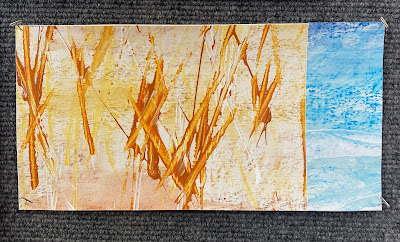 |
| millefleurs detail, The Unicorn in Captivity, The Cloisters, New York |
But this would be a southwestern millefleurs, full of the desert wildflowers, cacti, grasses and critters that I love. It would include all the surprisingly hardy and colorful tiny desert plants that bloom against all odds, as well as the beetle, the raven, the coyote and the scaled quail. It would convey the joy and exhilaration I feel when walking in the high desert landscape. To date I have taken 580 reference photos for this tapestry.
And, no surprise, I have found it impossible to put pencil to paper and start designing the darn thing. Sure, I have woven several small pieces focusing on individual plants or scenes that were more or less successful. But I had no idea how to design the Many-Splendored Millefleurs with all the plants and animals. Or rather I knew--one plant at a time, right?--but I just couldn't begin. I realized I needed professional help, and I reached out to fellow New Mexican and way-talented tapestry artist Elizabeth Buckley, who had recently offered her services as an online mentor.
I wrote to Elizabeth: I love the dense patterning of the traditional millefleurs backgrounds, and I adore the work of Dom Robert. But obviously I need to find my own take on the theme. Part of that is given to me by the subdued colors of our landscape. I want somehow to convey the idea of resilience, of hardiness and survival in harsh circumstances. And the vast open expanses here. Not sure crowding a million motifs together in the classical style is appropriate. . .
Elizabeth posed a few thoughtful questions about size, format, scale and crucially for me, horizon line (would there be one?), and somehow I was able to begin. Just having a fellow tapestry weaver to talk to about it—someone waiting to see progress—got me moving. For a couple weeks I fiddled around with dozens of ideas and approaches, looked at old collages, made lots of sketches, printed lots of photos, brainstormed lists of words. . . .and slowly, slowly, the thing began to come into focus. These are some ideas I tried and discarded, at least for now . . .
 |
| Molly Elkind (c) collage 2019 I have an idea of how to weave this relief piece but haven't tried it yet. |
 |
| Molly Elkind, collage (c) 2020. Grass and Sky textures |
 |
| Molly Elkind, collage (c) 2018. This old collage seemed surprisingly relevant, with its juxtaposition of abstract and realistic textures. |
Poetry not Prose
Vast – tiny
“faraway – nearby”
Colorful – drab
Organic – geometric
Smooth/flattened – rough/textured
Delicate – harsh
Profligate beauty – scarce resources
Limitlessness – limits
Hand-drawn line – photographic deep space
A key insight I’ve had is that my way of working has ALWAYS been to compose/make small individual units and then to combine/assemble them into larger wholes. So I’ve been thinking of various ways to break it down into panels or parts that look collaged. It just doesn’t feel right to me somehow to compose a unified pictorial surface; at least it’s not my usual way of working. I like the fragmented, disjointed collage-y surface.
And now this piece has become so different from what I thought it would be! Gone are the critters (sorry, scaled quail!). Gone are the wildflowers--except for patches of bright color here and there. It's all Sky and Grass now, the better to convey the emotions I'm after. The piece will have two panels, which may even be woven and hung separately, one vertical panel of sky on the right and a horizontal panel on the left representing grass textures. It is not as disjointed or collage-y as I might have thought, but it will feature two very different surfaces.
 |
| Molly Elkind, collage (c) 2020 |
 |
| Molly Elkind, Wild Grass (detail), (c) 2020 |
 |
| Molly Elkind, sketch (c) 2020 |
 |
| Molly Elkind, sketch (c) 2020 |
 |
| Molly Elkind, sky sample (c) 2020 |
Have you decided that this is the time to finally tackle that big project you've been dreaming about? Let me know!

9 comments:
This is such a walk with you on your tapestry journey. Yes, art never resembles those mental images once it gets underway. I really like the freedom of your approach. One reservation I have about tapestry is thst in a lot of hands it becomes tightly rigid, worrying about selvedges and technical accuracy. That's not how mine works, anyway.
Im looking forward to seeing your progress and discoveries on this piece.
YEEEESSSSSSSS!!!! I can't tell you how much I love this post. Thanks for sharing this process Molly. It is encouraging and so much fun to see. I can't wait to see the final piece! (But more about the process too please!)
Thank you, Rebecca! My hope is that other weavers ARE encouraged in their own process by knowing that it’s never a straight line. It’s taken forever for me to learn how to be led and to trust how things evolve.
Don’t worry, I’m sure I’ll be posting more about the process, ad nauseam!
Thanks for describing your elegant and thoughtful process, and it’s lovely results.
Thanks for reading, Dr. Lynn, and for your kind words.
For months I've been struggling with a design for a larger piece than I've ever woven before. This is so inspirational! It gave me some ideas. Thanks for writing it.
Phillenore, I’m SO glad you found this helpful. Good luck with your big piece!
Molly, this is so much fun to see where the design journey has taken you!
Thanks so much for your help, Elizabeth!
Post a Comment